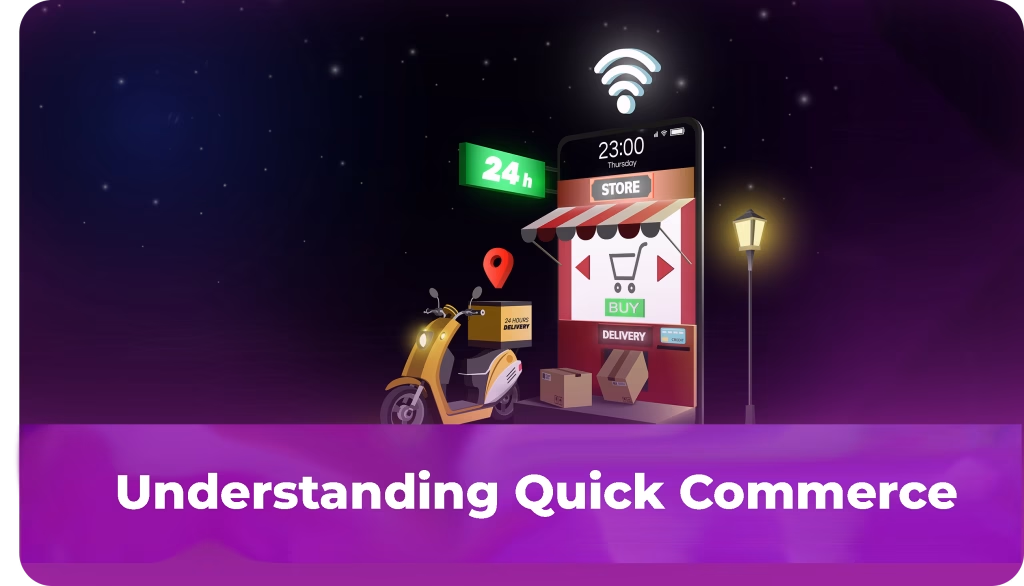Quick Commerce 101: What You Need to Know
If you’ve ordered groceries or snacks and had them show up in 20 minutes or less, you’ve already seen quick commerce in action. It’s fast, it’s local, and it’s changing how people shop online. While traditional eCommerce gave us the convenience of shopping from home, quick commerce takes it further by shrinking delivery times down to minutes.
In this article, we’ll look at how the quick commerce model works, how it differs from traditional eCommerce, and what it takes to build or manage a business in this space.
What Is Quick Commerce?
Quick commerce (sometimes written as q-commerce) is the ultra-fast delivery of small orders. These are everyday items — groceries, toiletries, pet food, or a quick snack run — people don’t want to wait hours or days to receive it. They want them immediately. And quick commerce platforms make that happen.
While regular online shopping usually delivers in a day or two, quick commerce aims for 10 to 30 minutes. People use it for immediate needs, like a forgotten dinner ingredient, a last-minute birthday candle, or a bottle of milk at 9 p.m.
These short delivery windows are possible because of how quick commerce platforms are set up. Most don’t have full-sized warehouses or retailers to fulfill orders. They operate through a network of local delivery hubs or dark stores (which we’ll get into in a bit).
eCommerce vs Quick Commerce
Next, let’s clear up the difference between traditional eCommerce and quick commerce.
In eCommerce, customers place an order online, and a warehouse processes and ships the item. That item often travels long distances and lands on your doorstep in one to three days. eCommerce works well for big-ticket items, bulk orders, or things you don’t need urgently.
Quick commerce, on the other hand, skips the long haul. It relies on local storage spaces and delivery riders to fulfill orders that are smaller in size and higher in urgency. You’re not buying a couch or a computer through a quick commerce app; you’re buying toothpaste, soda, or instant noodles.
In short, you use eCommerce for things you want later and quick commerce for things you need now.
Quick Commerce Platforms in Action
Quick commerce platforms are the digital engines behind this business model. These platforms give users an app to shop from, but they also run the backend: order management, inventory syncing, rider tracking, and payment handling.
Some popular names in the space include Getir, Gorillas, Blinkit, and Zapp. In the UAE and other Gulf markets, platforms like Careem Quik و Noon Minutes are leading the charge. They cover urban areas with high population density, where short delivery times make more sense logistically.
Behind the scenes, these platforms depend heavily on real-time data. When you place an order, the app checks the nearest dark store for stock, assigns a rider, and maps out the fastest route. All of this occurs in a matter of seconds.
What Are Dark Stores in Quick Commerce?
Dark stores are storage facilities that look like retail shops but are closed to on-site shoppers. You can visualize them as small, private warehouses placed inside residential neighborhoods. They’re stocked with fast-moving consumer goods and organized for speed, not display.
Dark stores sit at the center of the quick commerce model. They allow retailers to keep inventory close to customers without the cost or hassle of running a physical retail store. Since these stores don’t serve walk-ins, staff can focus entirely on picking and packing orders as soon as they come in.
In busy cities, companies often open multiple dark stores in different neighborhoods. This setup cuts down delivery distances and allows drivers to make more trips per hour.
نموذج الأعمال التجارية السريعة
The idea behind the quick commerce business model is simple: high-volume, low-margin sales with fast delivery and strong tech support.
This model runs on the following core elements:
- Limited inventory: Dark stores hold only what sells often and moves quickly.
- Small baskets, frequent orders: Most people order 3–5 items, but they may do it multiple times a week.
- Hyperlocal delivery: Deliveries are made within a radius of 2–4 km.
- Technology-driven: Real-time order tracking, smart inventory systems, and route optimization are all built into the platform.
But there’s a catch: to make it work, everything has to move fast and smoothly. Even a small delay in order picking or a discrepancy in inventory can throw off the entire delivery cycle.
Quick Commerce App Development
Building a quick commerce platform isn’t just about setting up a shopping app. The customer-facing front end is only half the picture. The backend is where the real challenge lies.
Quick commerce app development involves building multiple layers: customer interface, inventory management, rider dispatch, location tracking, payment processing, and performance analytics. The app needs to handle spikes in demand, update stock in real-time, and assign deliveries automatically to the nearest driver.
Speed is important at every level. If the app takes too long to load or crashes during checkout, you lose the sale. If the backend can’t assign orders quickly or show accurate inventory, you delay deliveries and frustrate customers.
To succeed, quick commerce apps have to run like clockwork across mobile, warehouse, and delivery operations.
Is Quick Commerce Profitable?
This is the big question everyone asks.
The short answer is: it depends. Profitability in quick commerce hinges on scale, order volume, and how tightly the operation is run. Margins on everyday goods are low, so businesses have to move a lot of them quickly and keep delivery costs under control.
Companies that use smart routing, minimize delivery distance, and automate processes tend to stay leaner. They also need to build customer loyalty, so people keep coming back. Offering fast, reliable service helps, but so does smart product selection. Stock what sells and skip what doesn’t.
It’s worth noting that some early players in the space struggled with profitability. They expanded too fast or spent too much on promotions. But newer models, especially in regions like the Middle East, focus more on efficiency from day one.
Why Is Quick Commerce Catching On?
People are getting used to faster service. Food delivery apps set the expectation, and now, customers want that same speed for everything else. Why wait two days for laundry detergent when you can get it in 20 minutes?
Quick commerce taps into that mindset. It gives people time back and cuts down on in-person store trips. For busy households, young professionals, or parents with small kids, that kind of convenience is crucial.
As urban areas grow and delivery networks get smarter, quick commerce is likely to grow with them. The key will be balancing speed with smart operations.
الأفكار النهائية
Quick commerce isn’t just a faster version of eCommerce. It’s a different way of shopping, really: one that’s built around instant needs, short distances, and tech-powered delivery.
From dark stores and smart routing to real-time inventory and AI-backed platforms, the quick commerce business model brings a lot of moving parts together. But when it’s done right, it creates a seamless experience that people quickly grow to love.
If you’re planning to build in this space or just want to understand how it all works, start by looking at the basics. What is quick commerce? How do quick commerce platforms operate? What does it take to run a fast, local, and reliable delivery service?
Once you answer those questions, the rest of the model starts to make sense.
Plus, if you need help with quick commerce app development, contact ميل today.
Our end-to-end SaaS solution handles everything from order management and fulfillment to dispatch and real-time tracking to proof of delivery and payment collection.


